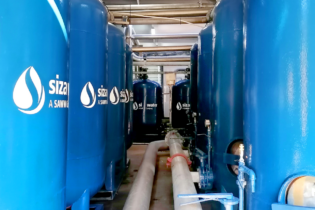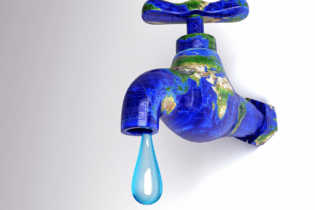The water risks facing South Africa cannot be addressed by government alone. Collaborative partnerships between the public and private sectors, such as those entered into by Sasol, will be essential to address the risks facing us all, says Andries Meyer, Senior Manager: Sustainable Water, Sasol New Energy.
The risks themselves are easily recognisable, with Sasol’s largest operations in South Africa dependent on the water-stressed Vaal River system, which supplies most of Sasol’s water requirements. “We are faced with a situation in the Vaal River system where the demand exceeds the sustainable supply of the system and water shortages will most likely be experienced during drought conditions, unless the demand – including water losses – is reduced significantly. This situation and the risk of water shortages will remain serious until completion of the Polihali Dam, part of the Lesotho Highlands Water Project Phase 2, by around 2022,” says Meyer. This is a critical business continuity imperative when one considers how integral to the day-to-day business of the locally based energy and chemical company water is. “Water is critical for the operation of the Sasol facilities and is mainly used for steam production and cooling. Our South African operations use approximately 110 million cubic metres per year or 4% of the total supply from the Vaal River system,” he explains. As such, Meyer believes that partnerships and collaborative efforts on a strategic level are important for aspects like policy development. “However, execution mostly takes place on a local or operational level, hence partnerships with local municipalities and communities are where most of the ‘real work’ happens,” says Meyer. This is precisely why Sasol is focusing its efforts in this arena, as well as fostering further strategic partnerships through its position as a founding member of the South African Strategic Water Partners Network (SWPN). “Sasol’s involvement with the SWPN evolved from our membership of the United Nations Global Compact CEO Water Mandate, as well as our involvement with the World Economic Forum initiative to establish the Water Resources Group (WRG). The SWPN is the South African ‘arm’ of the global WRG initiative. Similar collaborative platforms are being established in countries like Mexico, Jordan and Mongolia.” As a result of this comprehensive and unified approach to water stewardship globally, Sasol initiated the Sasol Water Sense campaign. Sasol Water Sense is the identity created for all of Sasol’s internal and external water stewardship initiatives. It includes internal initiatives to improve water use efficiency, development of technology to treat and reuse effluents, as well as external water conservation/awareness and education partnership initiatives. Committed to water loss reductionSasol, together with Rand Water, has made a commitment to help the Govan Mbeki Municipality reduce water usage by 15% by 2015. “The first two phases of the project entailed identifying the priority interventions in the municipality and repairing of households leaks in the eMbalenhle township – approximately 1 500 houses – having been completed,” says Meyer. The project, named Ithosi, means drop of water. The current, and third, phase of this water loss reduction initiative commenced earlier this year. “The third phase entailed the repair of household leaks in the Lebohang township, in the Leandra area, as well as establishing the feasibility of implementing pressure management in the Secunda area. This phase is mostly completed and discussions are in progress with the funding partners – Rand Water and the Govan Mbeki Municipality – regarding extending the project into a further phase,” says Meyer. The municipality is not only set to benefit from major savings, but the money saved will enable it to continue funding and implementing further water conservation projects. Sasol’s contribution of R1.5 million is part of the total partnership contribution of R4.5 million for the project, which first launched in 2011.The objective of this initiative is to stop the major water leakages that are a result of poor infrastructure, and wear and tear. As part of the retrofitting action, it was also decided to fit cisterns into more than 700 faulty toilets. The result was water savings of approximately 21 million litres per month – or 252 million litres per year. Sasol’s need to get involved in this project is unequivocal, according to Meyer. “The Govan Mbeki Municipality is home to our largest production facilities in South Africa, the Sasol Synfuels complex in Secunda, which manufactures a significant portion of the country’s liquid fuel requirement as well as a large range of chemicals from coal. The majority of the employees of the Sasol Secunda complex reside in the Govan Mbeki municipal area, hence the relationship with the municipality is very important to Sasol. We wanted to start with our water conservation partnerships ‘in our own backyard’ before proceeding to other areas in the Vaal River catchment.”
Flying the flag
This is just one of the recent projects Sasol has advanced through partnerships and funding. Further examples include the Busa Metsi and Boloka Metsi projects. “Boloka Metsi is our flagship water conservation partnership with the Emfuleni Municipality. It entails the repair of household and distribution system leaks in the Evaton and Sebokeng townships,” explains Meyer.
Meyer believes that in order to be successful with regards to water conservation and sustainable water management, a mindset change is needed. “From a private sector perspective, investments in water stewardship initiatives need to be elevated from the level of corporate social investment-type projects to a level of having a significant impact on addressing the water security and water quality risks facing South Africa. ” According to Meyer, in order to achieve this, government needs to create an incentive mechanism that will enable private sector role players to justify significant investments in external water conservation/quality improvement initiatives. “In this regard, we have proposed the establishment of a water offsetting mechanism, which has been included as ‘emerging policy’ in the National Water Resources Strategy 2. We are also currently collaborating with the Department of Water Affairs to develop a water offsetting policy, using the Boloka Metsi project as a case study ,” he explains. This is not only because the private sector needs to develop a social consciousness. “Despite it being important, the main motivation for Sasol’s water stewardship initiatives is not a social consciousness as a major water user, but rather a clear business imperative that we cannot sustainably operate our facilities or sustain the communities associated with our facilities without a secure supply of water,” says Meyer. He adds that addressing the risk of water security therefore has a direct business risk reduction motivation in addition to being part of the corporate social investment portfolio. As a result of the company’s holistic water stewardship focus, Sasol Water Sense, Sasol recently won the Water Management Award in the 2013 Mail & Guardian Greening the Future Awards. “It was very satisfying to receive recognition for what our initiatives managed to achieve and also provided additional motivation to continue on this journey.” He adds that the value of winning these awards goes far beyond simply the acquisition of another trophy or certificate. “In addition to providing internal motivation to the partners involved, it also greatly improves the public awareness and support from other stakeholders.” Public awareness is especially key in light of recent partnerships and projects, believes Meyer. “The municipal water conservation partnerships specifically have taught us that education, awareness and change of behaviour is as important as the physical fixing of leaking pipes, taps and toilets. Without a change in behaviour by the community, the repair of water leaks will not yield sustainable results.”








